Every water pump is made up of multiple interconnected parts, each of which has a direct impact on performance, efficiency, and reliability. Industry assessments show that premature pump failures are traced back to neglecting critical components such as seals, bearings, and impellers.
Small issues like worn wear rings, misaligned shafts, or clogged strainers may seem minor at first, but they quickly escalate into pressure loss, energy waste, and full pump breakdowns if left unchecked. Regular inspection of individual components ensures that pumps deliver stable flow, withstand harsh operating conditions, and run with minimal downtime.
This guide outlines the 10 most important parts of water pump that need maintenance.
Key Takeaways:
- Critical parts that need inspection include mechanical seals, bearings, impellers, shafts, couplings, casings, wear rings, gaskets, stuffing boxes, and strainers.
- Each part has its own wear patterns, seals degrade under pressure, bearings fail without lubrication, and impellers lose efficiency through corrosion or cavitation.
- Routine checks involve visual inspection, vibration monitoring, clearance measurement, and lubrication control, supported by proper OEM guidelines.
- Maintenance intervals vary: some parts require daily or weekly checks (like seals and bearings), while others need quarterly or seasonal reviews (like wear rings and impellers).
- Following a structured routine prevents cascading failures, cuts down repair expenses, and extends overall pump lifespan.
By understanding which pump parts need the most attention and why, you can build a preventive maintenance plan that strengthens reliability, lowers operating costs, and safeguards productivity across all pump applications.
Understanding the Importance of Parts of Water Pump
Every water pump is made up of multiple components working together under pressure, vibration, and fluid exposure. Over time, each of these parts is subject to wear, corrosion, or misalignment. Ignoring even one can lead to loss of performance, leaks, or full system shutdown.
Regular inspection and servicing of critical components ensures pumps run safely, efficiently, and with longer service life.
The importance of addressing these parts includes:
- Checking mechanical seals to prevent leaks that can damage bearings and compromise safety.
- Inspecting bearings to avoid overheating, vibration, and shaft misalignment.
- Maintaining impellers to preserve flow efficiency and prevent cavitation damage.
- Monitoring pump shafts and couplings to ensure smooth torque transfer and reduce vibration.
- Protecting pump casing from corrosion or cracks that threaten pressure containment.
- Measuring wear ring clearance to sustain pump efficiency and reduce energy loss.
- Replacing gaskets and O-rings to maintain tight seals and prevent contamination.
- Adjusting stuffing boxes or packing to balance leakage control and minimize friction.
- Cleaning strainers and filters to prevent suction blockage and impeller damage.
By paying attention to each of these critical parts, operators can detect early signs of wear, plan maintenance before breakdowns occur, and ensure pumps deliver consistent performance across demanding applications.
Now, let’s go step by step through the parts that need your attention.
10 Critical Parts of Water Pump That Need Maintenance
Industrial pumps are exposed to constant thermal, chemical, and mechanical stress. A single neglected part can affect performance, increase power consumption, or trigger shutdowns. Preventive care of each component is therefore essential.
Below is a detailed breakdown of the main parts of water pump that need maintenance, what to check, and why it matters.
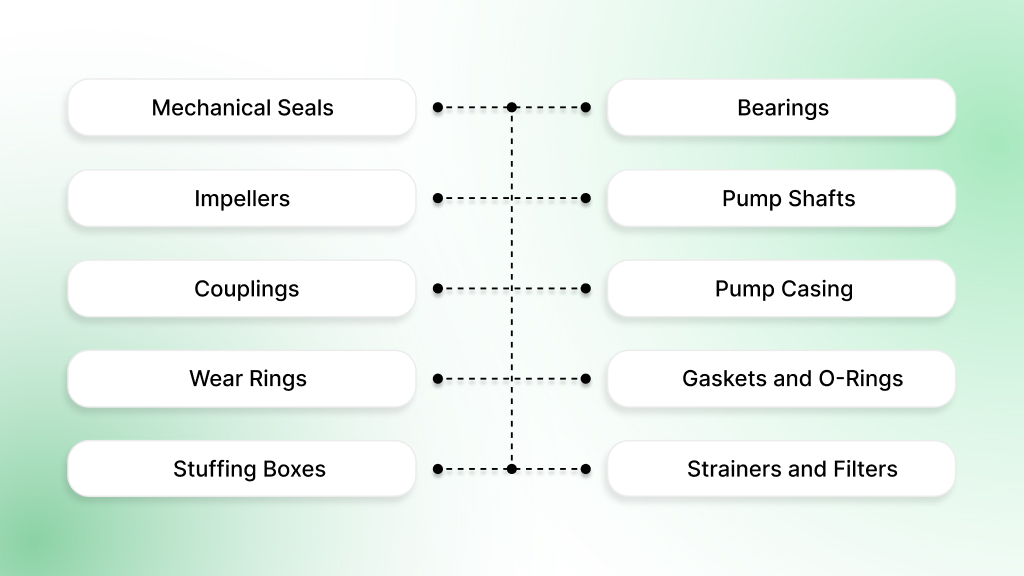
1. Mechanical Seals
Mechanical seals prevent process fluid from escaping along the rotating shaft. They operate under high friction, heat, and pressure. Seal failures are among the most common causes of pump breakdowns.
What to check:
- Seal face wear, scratches, or pitting
- Proper flush fluid pressure and cleanliness
- Elastomer swelling, hardening, or chemical attack
- Spring or secondary seal fatigue
Why it matters: A compromised seal causes leaks that damage bearings, contaminate process fluids, and create safety hazards in flammable or toxic services.
2. Bearings
Bearings support the shaft and reduce friction during rotation. They are sensitive to lubrication quality and contamination.
What to check:
- Bearing temperature (logs over time)
- Noise or vibration patterns indicating wear
- Grease or oil levels, type, and condition
- Excessive axial or radial play
Why it matters: Bearing damage increases shaft misalignment, accelerates seal wear, and can seize the pump completely. Predictive vibration analysis is often used to catch early faults.
3. Impellers
The impeller transfers energy from the motor to the liquid. Even minor wear reduces efficiency significantly.
What to check:
- Cavitation damage (pitting or erosion on vane surfaces)
- Scaling, fouling, or clogging from solids
- Diameter reduction due to erosion (>2 mm loss is critical)
- Balance condition (imbalance increases vibration)
Why it matters: A damaged impeller forces the motor to work harder, raising energy costs and reducing overall system reliability.
4. Pump Shafts
The shaft connects the motor to the impeller. Its strength and alignment are crucial for stable operation.
What to check:
- Straightness and run-out with dial indicators
- Shaft sleeve condition (erosion, grooving)
- Surface wear at sealing or packing areas
- Alignment with motor coupling
Why it matters: Shaft deflection or misalignment causes vibration, premature bearing failure, and seal leakage.
5. Couplings
Couplings transfer torque between motor and pump shaft. They also absorb small amounts of misalignment.
What to check:
- Wear marks, looseness, or cracked elastomer inserts
- Angular and parallel misalignment with laser or dial gauge
- Evidence of heat discoloration (overload)
- Coupling guard condition for safety
Why it matters: Misaligned or worn couplings transmit vibration, shorten seal life, and waste energy.
6. Pump Casing
The casing provides pressure containment and protects internal parts. Exposure to corrosive or abrasive fluids weakens it over time.
What to check:
- Erosion or thinning wall thickness (use ultrasonic testing)
- Cracks near flanges, nozzles, or weld seams
- Coating wear or blistering
- Leakage at joints or drains
Why it matters: A weakened casing compromises system safety, especially at high pressure or high temperature.
7. Wear Rings
Wear rings act as a sacrificial barrier between impeller and casing. They control internal leakage and efficiency.
What to check:
- Clearance increase beyond OEM tolerance
- Grooving or sharp edge wear
- Signs of galling or fretting
- Material compatibility with pumped fluid
Why it matters: Excessive clearance increases recirculation, reduces efficiency, and stresses the impeller.
8. Gaskets and O-Rings
Gaskets and O-rings seal static joints. They degrade quickly under high heat, aggressive chemicals, or poor installation.
What to check:
- Hardening, swelling, or cracks
- Flattening (compression set)
- Signs of leaks around bolted joints
- Compatibility of material with fluid
Why it matters: Small gasket failures escalate into leaks that reduce system efficiency and cause safety concerns.
9. Stuffing Boxes (for Packed Pumps)
Stuffing boxes use packing rings to restrict leakage where the shaft exits the casing. They require regular adjustment.
What to check:
- Packing gland tightness (avoid over-tightening)
- Leakage rate (a small controlled drip is normal)
- Shaft sleeve scoring or wear
- Packing ring condition (hardening or burning)
Why it matters: Poorly maintained packing overheats, damages shafts, and increases power draw.
10. Strainers and Filters
Strainers prevent solids from entering the pump. A clogged strainer starves the pump of fluid, leading to cavitation.
What to check:
- Blockages, corrosion, or collapsed mesh
- Differential pressure across the strainer
- Cleaning interval records
- Correct mesh size for process fluid
Why it matters: Clean strainers ensure steady suction conditions, reduce impeller wear, and protect seals from abrasive particles.
Now that you know the critical parts that require care, it is time to focus on the best practices to maintain your water pump components effectively.
Best Practices for Maintaining Water Pump Components
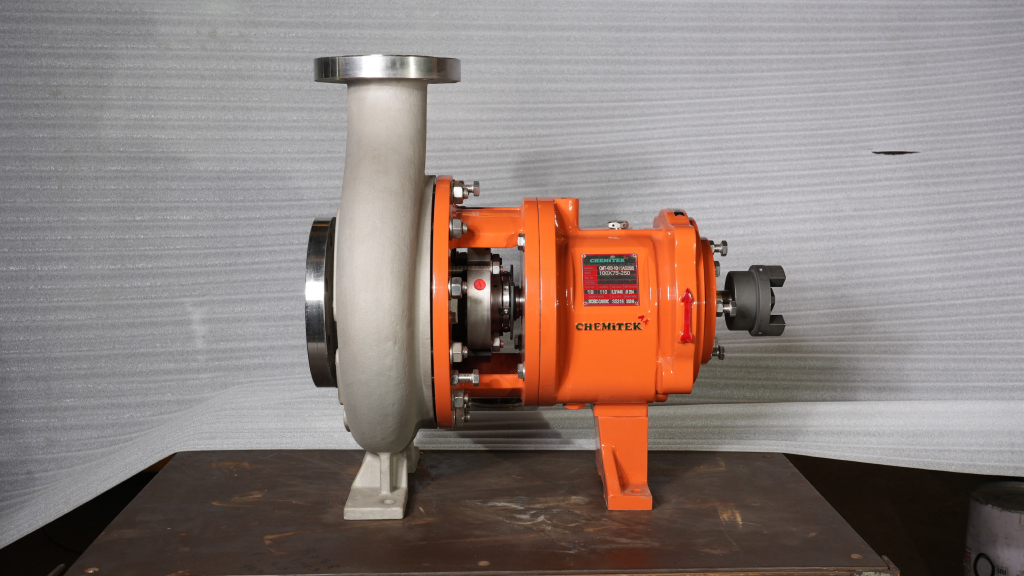
Water pumps operate under demanding conditions, and their reliability depends on consistent upkeep of key components. Industry reports highlight that neglected impellers, seals, and bearings are responsible for a large share of failures.
Here is a focused look at the best practices that extend pump service life.
- Impellers: Inspect quarterly for wear, scaling, or clogging; clean debris; replace if erosion >2 mm; use hardened impellers for abrasive media.
- Mechanical Seals: Check weekly for drips or wear; use fluid-compatible seals; replace at early signs of damage.
- Bearings: Lubricate per OEM schedule (1,500–3,000 hrs); use correct grease/oil; monitor vibration and temperature.
- Shaft & Sleeves: Check alignment with dial/laser tools; inspect sleeves for grooves; replace when wear is significant.
- Couplings: Inspect monthly for cracks or looseness; check alignment after thermal changes; replace flexible elements per OEM.
- Pump Casing: Inspect quarterly for corrosion or cracks; apply protective linings; maintain foundation integrity.
- Wear Rings: Measure clearance; replace if beyond limits; always pair with new impellers.
- Gaskets & O-Rings: Replace during servicing; use fluid- and temperature-compatible materials; avoid reuse.
- Stuffing Box/Packing: Adjust evenly for minimal leakage; replace if hard, brittle, or leaking excessively.
- Strainers & Filters: Clean routinely; inspect weekly for dirty fluids; replace damaged mesh/baskets.
Is your team struggling to maintain these critical pump parts? Chemitek provides end-to-end solutions with durable components, preventive maintenance support, and OEM-grade replacements to extend pump life and ensure system reliability.
Chemitek: Expert Care for Water Pump Components
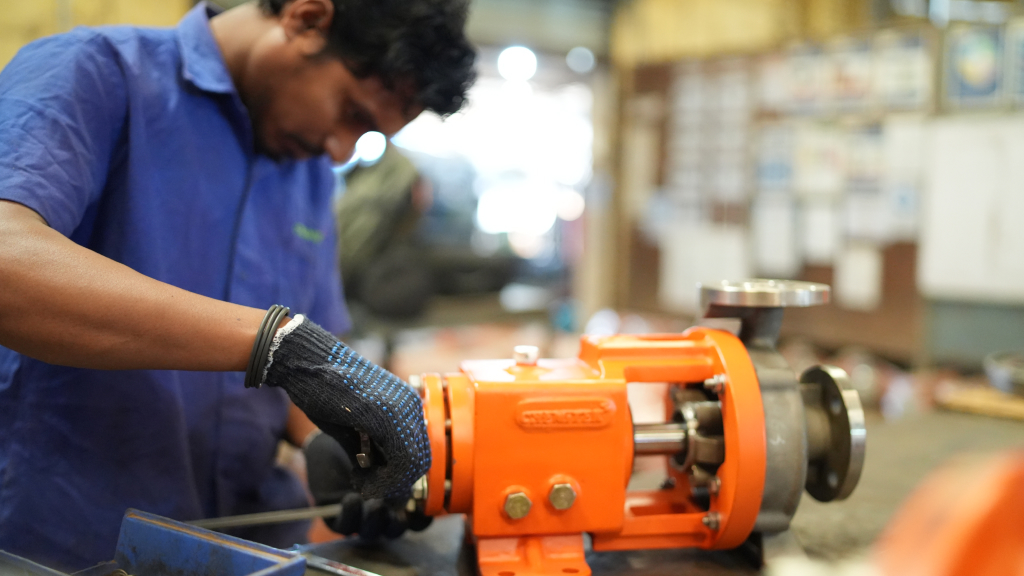
At Chemitek Process Equipment Pvt. Ltd., we recognize that long pump life depends on proper care of each component. Since 2009, we have supplied centrifugal pumps crafted from SS316, Alloy 20, Hastelloy, and other high-performance metals. Every unit complies with ANSI-compliant configurations or ANSI/ASME B73.1 standards and is verified to deliver under challenging operating conditions.
From seals and impellers to shafts and bearings, every part needs attention to maintain reliable flow. Chemitek works with industries to extend pump longevity, improve efficiency, and reduce unplanned downtime with practical maintenance solutions.
Get in touch today to select a pump that matches both your process requirements and servicing priorities.
FAQs
1. Which water pump parts require routine care?
Mechanical seals, bearings, and impellers are the most maintenance-sensitive parts because they face constant motion, pressure, and wear.
2. Why are seals a key focus in pump servicing?
Seals stop leakage along the shaft. If seals degrade, pumps fail quickly. Regular cleaning, lubrication, and condition checks are essential.
3. How frequently should impellers be inspected?
Quarterly or semi-annual checks are ideal. Cavitation damage, erosion, or corrosion reduce pumping efficiency and must be corrected early.
4. What function do bearings serve in pumps?
Bearings keep the shaft stable and reduce friction. Signs like overheating, noise, or vibration signal that lubrication or replacement is required.
5. Why is it important to check shafts and couplings?
Poor alignment or worn couplings cause vibration, excessive energy use, and part damage. Alignment checks and balance adjustments are critical.
6. Does the pump casing also need maintenance?
Yes. The casing holds pressure and protects internal parts. Cracks, thinning, or erosion are common in abrasive or corrosive services and must be monitored.
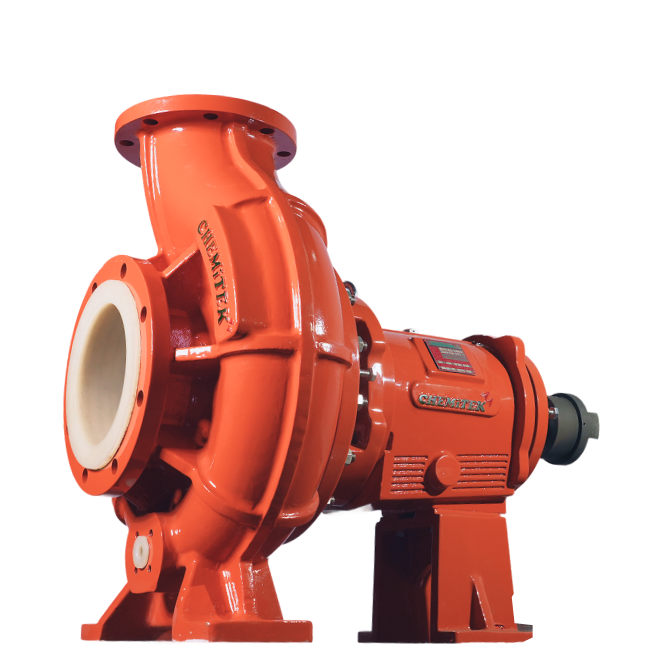
Latest posts
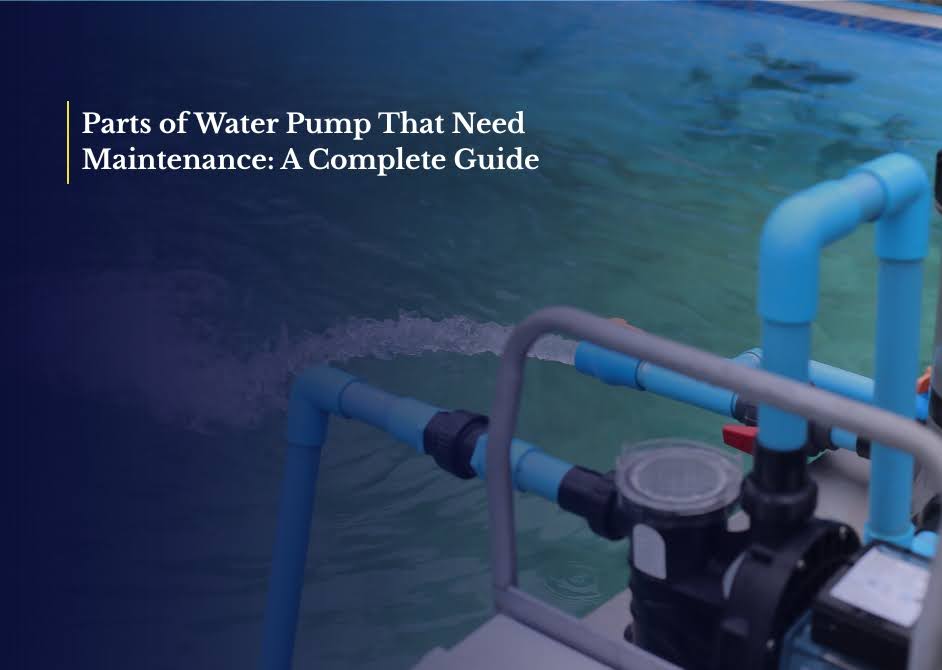
Parts of Water Pump That Need Maintenance: A Complete Guide
Ready to Upgrade Your Process Operations?